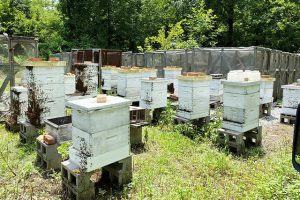U.S. DEPARTMENT OF AGRICULTURE
Varroa Mites and Deformed Wing Virus Make Honeybees More Susceptible to Insecticides
Contact: Jessica Ryan
Email: Jessica.Ryan@usda.gov
Controlling for Varroa mites, the parasitic mites that feed on honey bees and serve as vectors for viral diseases like deformed wing virus (DWV), can help with improving honeybee populations and make bees less susceptible to harmful insecticides, according to a recent study published in Environmental Pollution.
Foraging honey bees may be directly exposed to toxic insecticide sprays in the field or exposure may come from honeybees collecting and bringing pesticide-contaminated pollen and nectar back to their hives to feed larvae and young bees. The presence of insecticides, along with other environmental stressors in agricultural areas, can be a factor leading to issues like colony loss – something beekeepers from around the world are trying to overcome.
“Previous research has shown how chemicals like pesticides make bees more susceptible to mites,” said Yu-Cheng Zhu, a research entomologist at ARS’s Pollinator Health in Southern Crop Ecosystems Research Unit in Stoneville, Mississippi. “In our study, we wanted to see if mites and viral infestations make bees more susceptible to insecticides.”
In a study, researchers with the U.S. Department of Agriculture (USDA)’s Agricultural Research Service (ARS) applied the miticide amitraz (Apivar), a product commonly used for treating Varroa mites, off-label to four bee hives and left the other four hives untreated. They monitored the mite population density monthly and DWV density in early, middle, and late season.
Researchers collected bees from miticide-treated and untreated hives, and quantified gene expressions of four immune genes and two physiology-related genes. They also tested bees’ sensitivity to five representative insecticides. In addition, bees’ natural mortalities were recorded during three seasons.
“Miticide treatment led to minor or undetectable mite and DWV infestations during the whole bee season, while untreated colonies had substantially higher mite and DWV infestations,” said Zhu.

The first of two apiaries, established in 2014 in Stoneville, Mississippi, provided honey bees for studying the impact of pesticides on honey bees. (Photo by Yu-Cheng Zhu, D5121-1)
The data analyses showed that Varroa mite population irregularly fluctuated over the bee season and mite population density was not dynamically or closely correlated with the seasonal shift of honey bee natural mortality. Unlike mites, DWV density in untreated colonies progressively increased over the bee season. The density was highly correlated with the seasonal increase in honey bee natural mortality.
“In the untreated hives, the increased DWV infestations resulted in decreased physiological and immunity-related functions in late-season honey bees, making the bees more susceptible to insecticides and increasing natural morality rates during the season,” said Zhu.
According to Zhu, Varroa mites, also known as Varroa destructor, can reduce fat body and body fluids that contain important detoxification enzymes and immune proteins in honey bees. As a result, bees have impaired immune, detoxification/defense systems, and other essential processes. Coupling those impairments with exposure to insecticides can be detrimental to bee populations.
“Having impaired immunity, especially later in the season with fewer food sources, can be challenging for honey bees,” said Zhu.
Zhu, whose work focuses on the toxicological impact of pesticides on beneficial insects in the Mississippi Delta Area, said that the study’s results indicated the importance of studying the “bottom-up” effects of mite infestations on the overall health of honey bees in real-world contexts.
“Chemical control is still a major method in preventing crop loss and controlling insect pest populations,” said Zhu. “It is important to study the effects of chemical control in honey bee populations so we can find best practices for protecting the health of bees.”
We are here to share current happenings in the bee industry. Bee Culture gathers and shares articles published by outside sources. For more information about this specific article, please visit the original publish source: Varroa Mites and Deformed Wing Virus Make Honeybees More Susceptible to Insecticides : USDA ARS









